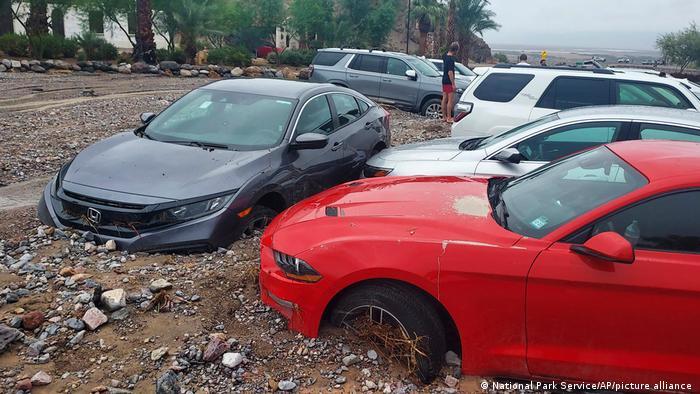Flooding in Death Valley, California, on Friday stranded some 1,000 visitors, buried cars, and shut down all of the park’s roadways.
According to the National Park Service, no one was hurt, but roughly 60 vehicles were stranded due to debris that had accumulated to a depth of several feet.
According to the National Area Service, “unprecedented levels of rainfall” produced “significant flooding,” which has left “about 500 visitors and 500 personnel currently unable to exit the park,” which is located in Eastern California’s Mojave Desert.
Floodwaters tore up paved roadways and pushed dumpsters into parked cars, resulting in collisions between the two types of vehicles. According to the park, offices and hotels were also affected by the flooding.
The park administration has noted that all park roads would stay closed until officials can establish the extent of the damages.
The park’s Furnace Creek section received a total of 1.46 inches (3.7 cm) of rain, nearly equaling the previous daily record of 1.47 inches. There is an average of less than two inches of rain per year in this area.
Climate change causes the atmosphere to retain more moisture, resulting in greater rain.
Some places would see an increase in frequency, severity, and quantity of heavy rains even if the global temperature rises to 1.5 degrees Celsius, according to UN climate experts.
As the temperature rises, so does the likelihood of storms with a lot of rain.
Over a thousand people were left stranded, automobiles were buried, and the park’s entrance and exit roads were closed as a result of Friday’s flash floods in Death Valley, California.
According to the National Park Service, no one was hurt, but roughly 60 vehicles were stranded due to debris that had accumulated to a depth of several feet.
When the National Area Service said that “about 500 visitors and 500 workers are currently unable to escape the park,” they were referring to the floods produced by “unprecedented levels of rainfall.” The park is located in Eastern California’s Mojave Desert.
Floodwaters tore up paved roadways and pushed dumpsters into parked cars, resulting in collisions between the two types of vehicles. According to the park, offices and hotels were also affected by the flooding.
The park administration has noted that all park roads would stay closed until officials can establish the extent of the damages.
The park’s Furnace Creek section received a total of 1.46 inches (3.7 cm) of rain, nearly equaling the previous daily record of 1.47 inches. There is an average of less than two inches of rain per year in this area.
Climate change causes the atmosphere to retain more moisture, resulting in greater rain.
Some places would see an increase in frequency, severity, and quantity of heavy rains even if the global temperature rises to 1.5 degrees Celsius, according to UN climate experts.
As the temperature rises, so does the likelihood of storms with a lot of rain.
